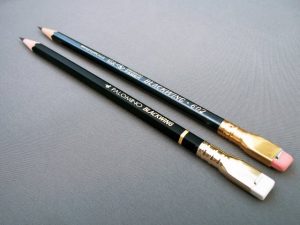What Kind of Pencil Do You Write With
The title of this post is a well-known story that Stephen King, prolific author and essentially living legend of fictional narratives, tells about a time he was doing a Q & A with fans and one asked this question. His response:
Blackwing 602 #2 pencil, longhand.
While they look like pretty nice pencils, and cost only $22 for a 12 pack, a question and answer like this doesn’t seem to serve much of a purpose.
Could King have written the Dreamcatcher using a fountain pen? Yes, and in fact, HE DID.
Could he have typed those iconic words on a computer? Yes, and in fact, he did until a car accident made it painful and uncomfortable to sit at a computer.
Will using these same writing implements mean you’ll possess the same creative abilities as someone like Stephen King? Likely no.
Many of histories best writers have used nothing more than pen or pencil and paper, likely because automated type wasn’t available until the last century. You’d be hard pressed to find many writers who use anything other than a word processor these days, although there are still throwbacks like King and also J.K. Rowling who rely on pen and paper for their work.
While understanding the creative process can be important, it’s also important to understand that creativity doesn’t have a process. Whether you set up your office a certain way or prefer the feel of paper under your palm versus the glare of a computer monitor usually doesn’t affect whether you produce good or even great work with either. As King put in his highly recommended book “On Writing” when discussing the creative process:
We are writers, and we never ask one another where we get our ideas; we know we don’t know.
Immediately after that part, he talks about asking another writer what question she never gets asked during a Q &A and her response is “No one ever really asks about the language,” meaning the entire point of the writing style itself. How the scene is set, the choice of hyperbole to explain a situation, the verbal brushstrokes that paint the picture in the readers brains that make the entire story come to life.
No, they ask which kind of pencil they use.
In fitness, the parallels to this are incredibly succinct, mainly because there are a lot of parallels between writing well and a sound fitness program, especially one being given to someone else. The one you give to yourself is akin to a post-it note telling you to get bread on your way home from the store, and in many cases your workout may actually be on a post-it note.
To write well, there’s a flow of concepts, from initiation through climax of activity to followthrough, all involving rules like grammar, syntax, spelling, paragraph structure, and train of thought. Then there’s the elements that play within those rules, such as descriptives, character development, scenes, known versus supplanted versus assumed details, plots, and any other source of depth to telling the story.
In training, there are similar features. The rules are basic principles like Specific Adaptation to Imposed Demands, Law of Repetitive Motion (chronic strain injury mechanics), Wolfe’s Law (adaptation of bone to mechanical stress), sliding filament theory (muscle contraction physiology), and Krebs cycle (metabolic pathways of different substrates during activities). Within these principles are the specific activities, motions, intensities, and variations of movement that can produce a workout, regardless of whether it’s in the gym or not.
I’ll give you an example:
When I do a consult with a new client, I have a few pieces of paper on a clip board and write notes. Most of the papers are relatively blank, except for specific spots for things like injury history, medication, goals, etc. I write out what I see and what things pop up in terms of being important to that clients’ goals and needs.
From there, I design their program on a computer with an Excel file template. Essentially, I write in exercise names into the cells and the Excel file makes it look somewhat better than chicken scratch I tend to refer to as hand writing. From there, I print the files and bind the pages into a small hand book I give to the client so they can see what the workouts are and do them on their own when possible, and also so I can keep track of what we’re doing and how progress is coming.
Some trainers use video assessment software to record their findings, others work off of whiteboards and then take a picture of the board at the end. Others use a tablet, take pictures, use flash cards, smoke signals, or some other cool technology I’ve never heard of before. For their workouts, they may record everything on a computer, write everything out by hand, use playing cards, a white board, or just make things up on the fly.
Their ability to be a coach isn’t depending on what process they use to get to their end result, which is delivering coaching and an experience to their clients.
Similarly, working in a commercial gym I see a lot of members come in with various programs to work from. Some are written out on post-its, others scrawled on a sheet of loose leaf paper. Some keep their workouts in a journal to refer back to, others work from the booklets I give them. Some come in with magazines or just the pages of the magazine with the workout they’re intending to do written on it, a book, or others may work off of an app on their smart phone.
Everyone has a different way of tracking or looking up their workouts. The manner in which they access them doesn’t matter as much as the fact that they have a way of accessing them and doing them effectively. All coaches have different ways of writing out their programs or doing their consultations. What they have success with will not be the same as another, and may not guarantee success for someone else looking to use a similar process or device.
In many ways these tools tend to follow the Pareto Principle, commonly known as the 80/20 principle, in which 80% of progress seems to come from 20% of inputs, but not necessarily the reverse of this. In other words, spending time thinking about the pencil being used doesn’t produce any benefit, nor does trying to find the perfect app, lighting, or time of day to work out and ensuring they have their post-workout meal prepped and ready to go so they can hit that anabolic window flying. They may all play a role, but eventually, you still have to get in the workout.
There’s also the concept of a plan B. If your pencil breaks, your paper gets ripped, it’s busy in the gym and all the squat racks are being curled or your smart phone has spotty reception because the gym is in a bunker in the middle of a warzone in Syria, you’ll need a different way of tracking or knowing how to get through the workout, so plan for a backup.
https://www.youtube.com/watch?v=3Gy1BH1-TPA



One Response to What Kind of Pencil Do You Write With